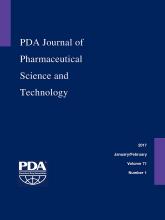Abstract
In manufacturing settings, control limits are often set using a three-sigma rule (i.e., three estimated standard deviations above and below the estimated mean). More sophisticated statistical methods might include the use of confidence, prediction, or tolerance intervals. However, in environmental monitoring of microbial excursions in aseptic manufacturing operations, most of the assayed measurements fall below the limit of quantitation. In such circumstances, it is inappropriate to directly calculate control limits with a mean plus two or three standard deviations to represent the center and spread of the data. The system under consideration assumes that microbial assayed values stem from a log-normal distribution with two sources of variability to account for testing occasions and measurements made within a testing occasion. Bayesian statistical methods and a Tobit likelihood are used to model the observed and left-censored data in order to predict the distribution of new data. Control limits are generated from quantiles of the posterior predictive distribution.
LAY ABSTRACT: In manufacturing settings, control limits are used to ensure either the manufacturing process or environment is in a state of control. These limits can be set using a three-sigma rule (i.e., three estimated standard deviations above and below the estimated mean) or via more sophisticated statistical methods. In this paper, we consider setting the control limits for a clean room setting in which microbial excursions are rare. Under such circumstance, the measurements of microbial counts are often below the limit of quantification. We develop methods based on Bayesian analysis and a Tobit regression to more accurately estimate control limits.
- © PDA, Inc. 2017
PDA members receive access to all articles published in the current year and previous volume year. Institutional subscribers received access to all content. Log in below to receive access to this article if you are either of these.
If you are neither or you are a PDA member trying to access an article outside of your membership license, then you must purchase access to this article (below). If you do not have a username or password for JPST, you will be required to create an account prior to purchasing.
Full issue PDFs are for PDA members only.
Note to pda.org users
The PDA and PDA bookstore websites (www.pda.org and www.pda.org/bookstore) are separate websites from the PDA JPST website. When you first join PDA, your initial UserID and Password are sent to HighWirePress to create your PDA JPST account. Subsequent UserrID and Password changes required at the PDA websites will not pass on to PDA JPST and vice versa. If you forget your PDA JPST UserID and/or Password, you can request help to retrieve UserID and reset Password below.






